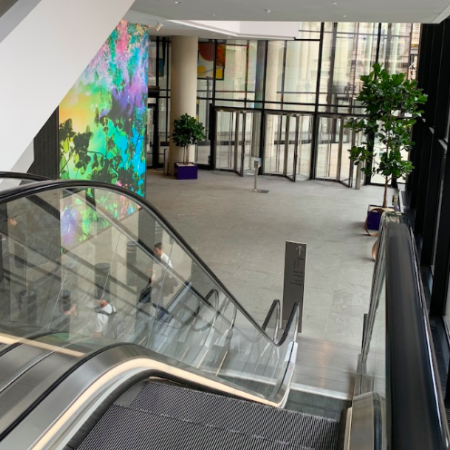A Cutting Edge Communications System for Safety and Efficiency at 22 Bishopsgate
CSE Crosscom delivered a solution for 22 Bishopsgate using the latest advancements in two-way radio and push to talk over cellular (PoC) mobile and Wi-Fi technology to provide reliable communications for security and facilities management teams throughout the site.
“Using their own considerable expertise, CSE Crossom worked really closely with their suppliers to design a solution which delivered on our requirements for a state-of-the-art safety system in keeping with the people-centric ethos of TwentyTwo”
Peter Bicknell, Head of Engineering 22 Bishopsgate at JLL
22 Bishopsgate is a state of the art building designed to provide a humanistic space that any of us would want to work in. Every aspect of the design is intended to be as people-centric as possible, enabling networking and collaboration by employing the most effective, relevant innovations, including a cutting edge communication system that reflects this.
An essential part of creating an environment that people want to be in is ensuring that everyone who enters is looked after, so 22 Bishopsgate needed a communications solution to manage the safety and protection of the building’s community in the event of an incident. As with all aspects of 22 Bishopsgate, the communications solution was specified to harness cutting edge, relevant technology to ensure the best possible solution.
The Challenge
22 Bishopsgate has the capacity to accommodate 12,000 people over 62 floors. In the event of an incident, evacuation needs to be coordinated safely and effectively using a reliable communication system. Under normal circumstances, conventional mobile phones operating over public networks or in-building Wi-Fi could offer a potential solution, but in a critical scenario this would not provide the reliable communication needed to ensure the safety of so many people. A two-way radio solution for the critical fire evacuation routes throughout the core of the building was therefore chosen.
Once the client had decided on using professional two-way radio as the communication solution, the next major challenge was obtaining radio frequencies from OFCOM to operate the radio system within the building. Two challenges quickly presented themselves; firstly, very few spare frequencies were available in the City of London area, and secondly, it would be very difficult and costly to try and restrict radio coverage within the building to prevent interference with other radio users in the surrounding area. The height of the building would intensify this problem as it would effectively act as a huge antenna transmitting beyond the approved coverage area.
The final challenge was the radios themselves. Whilst two-way radio is an extremely reliable and effective solution for critical comms, the radios haven’t yet been designed to operate the advanced applications the client wanted to use for the building, which are typically available on mobile phones.

The Solution
To solve the problem of license and frequency availability, CSE Crosscom used Tait Communications’ technology for the two-way radio system. The Tait system is unique in that it makes use of frequencies available in the Band III spectrum, which are more readily available in the London area and throughout the UK.
To solve the issue of radio coverage spreading beyond 22 Bishopsgate and potentially interfering with other radio systems, CSE Crosscom used a purpose designed distributed antenna system (DAS) in the core of the building for the two-way radio system, where the use of elevators and stairwells for safe evacuation makes the reliability of emergency communication critical to safety. The design of the DAS system ensures that two-way radio communications does not extend beyond the core of the building, thereby satisfying OFCOM requirements.
CSE Crosscom solved the final challenge by offering a fully integrated hybrid solution using two-way radio devices for critical comms in the evacuation routes throughout the core of the building and mobile network/Wi-Fi devices throughout the rest of the building, enabling the client to run their own 22 Bishopsgate apps and ChatterPTT on the same mobile device.
“We cannot compromise on the reliability of communications. In the event of an incident, we need to have total confidence that our communications systems will ensure the continued safety of our people. We also wanted a system that would enable us to integrate the latest in building technologies and apps so that managing the space could be efficient and intuitive. Based upon advice from CSE Crosscom, we chose to deploy a hybrid solution using two-way radio for the critical communication areas of the building, such as evacuation routes, and a mobile/Wi-Fi based solution for the rest of the building. A crucial point for us is that these two systems are fully integrated to allow full communications between two-way radio and mobile devices throughout the building”
Peter Bicknell, Head of Engineering 22 Bishopsgate at JLL
Using PoC to extend coverage
ChatterPTT , a Push to Talk over Cellular (PoC) app which can be loaded onto any smart device, extend the coverage beyond the spine of the building and provide for management and facilities management. It enables authorised employees at 22 Bishopsgate – throughout the building and beyond – to connect with the radio network and use their device like a two-way radio (for example, using one-to-many communication, which cannot be done with a conventional mobile phone). This extends the coverage of the two-way radio system beyond the core of the building to anywhere in the world where a mobile or Wi-Fi signal is available. This has proven to have the added benefit when staff need to work from home of keeping colleagues connected. 22 Bishopsgate’s hybrid system is the first to integrate Band III and PoC in the UK, and possibly the world.
Designed for safety
The client wanted the system at 22 Bishopsgate to be about more than just ‘voice’ communications, and to offer other benefits to the health and safety and operational efficiency of the building. CSE Crosscom proposed a customised solution to enable the client to monitor mobile and radio user locations throughout the building, to manage alerts and help to coordinate staff more effectively in the event of an emergency.
22 Bishopsgate’s system has been designed to incorporate features to specifically provide for the safety of those looking after the site, including emergency alerting, indoor and outdoor location tracking, and monitoring of personnel working in high risk areas.
Following consultation with CSE Crosscom the client chose to deploy SONIM ruggedised mobile handsets for staff using ChatterPTT. These devices, like the two-way radios, have a dedicated ‘Push to Talk’ and ‘Emergency Alert’ button. Both the two-way radios and the SONIM devices support indoor location tracking using Bluetooth beacons located throughout the building. GPS is used to track devices outside the building.
The control room at 22 Bishopsgate uses a specially developed cloud-based software platform – Logic Connect, to track the location of radio and mobile devices and monitor and manage emergency alerts received from the devices. For people with roles in high-risk areas, a ‘Lone Worker’ feature is included with the Logic Connect software to provide even better safety monitoring and ensure prompt assistance is available in the event of an accident or incident.
Logic Connect can run on any authorised smart device. In the control room deploys it on a professional tablet device, allowing users to untether the unit from the control room and continue with incident management in the event that the control room is not accessible.

Working with CSE Crosscom
“CSE Crosscom listened to our requirements and were able to come up with an innovative and cost-effective solution to meet our needs.
CSE Crosscom has a great reputation and experience in delivering large scale complex communication projects. Most importantly for us, they have a good track record in designing and delivering systems to provide enhanced communication and safety.
After detailed discussions with JLL and site visits before and during construction, CSE Crosscom was able to propose a solution using the latest advancements in two-way radio and push to talk over cellular (PoC) mobile and Wi-Fi technology to provide reliable communications for our security and facilities management teams throughout the site. I think it was of great benefit to get CSE Crosscom involved early in the development. This enabled us to properly integrate the communication system into the heart of the building rather than try to bolt this on afterwards.
CSE Crosscom is responsible for ongoing support and maintenance. The system is very scaleable and can be integrated with building management and alarm systems etc. This will help further streamline building management in the future should this be something we want to do so there’s a good level of future proofing available to us if we need it.”
Peter Bicknell, Head of Engineering 22 Bishopsgate at JLL
